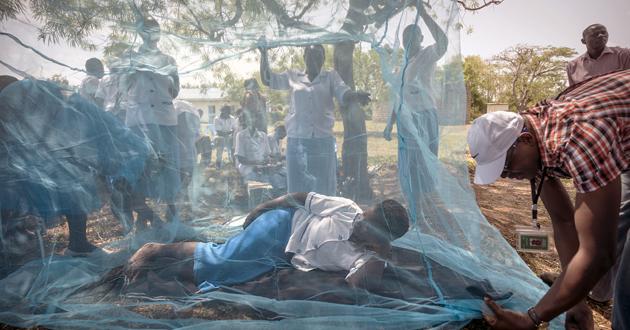COVVI-19 is the alarm signal for health equity: let's take the opportunity to help women get out of the nightmare from the cervix of the cervix
The Covid-19 pandemic awakened the collective conscience of the whole world, perhaps more than ever in modern history, on the need for equitable access to health for all.
But we only know too well another global nightmare in health that, for many decades, has been both one of the most visible examples of health inequalities and one of the most easily avoidable managers of deathin women in the world, especially in Africa.
College cancer is the fourth row of the most common cancers in women in the world.In the countries most at risk, mainly in sub -Saharan Africa, 75 in 100,000 women suffer from this type of cancer, against less than 10 women in low -risk countries.
If the interventions available are not implemented, the number of new cases of cervical cancer should go from 570,000 in 2018 to 700,000 by 2030, and the number of deaths from311,000 to 400000 per year.
As is the case for COVID-19, inequalities are at the heart of the cervical cancer crisis, the incidence of which is almost twice as high in low or intermediate income countries than inhigh -income countries.In addition, almost 90 % of deaths occur in low or intermediate income countries.
This tragedy is played mainly in Africa, breaking the hopes and lives of many girls and women.And it has significant consequences on their families and their community, as well as on national efforts to achieve progress and achieve targets relating to health and development set by sustainable development objectives.
On this World Action Day for the elimination of cervical cancer, we unite our votes to ask that urgent measures be taken to make the vaccines, tests and treatments available, so that allgirls and women, wherever they live, regardless of their age or income level, can have access to these essential tools that save lives.

The disparities are manifest and must be corrected without further delay.
For example, 79 countries concentrate 6 out of 10 cases of cervical cancer.But none of these countries yet has the vaccine that protects from this disease by preventing infection by human papillomavirus.On the other hand, high -income countries, where the load of this disease tends to be the lowest, have been able to launch large -scale vaccination campaigns, including for boys in the majority of them.
We must remedy this imbalance.
We are all engaged in the fight against cancer of the cervix, which is at the heart of the World WHO Initiative (in English) adopted by the countries a year ago to eliminate this disease from the livingThose who are today young girls.
To achieve this objective, all countries must achieve and maintain an incidence rate of less than four cases per 100,000 women.To do this, it is necessary to act in three key areas by 2030.
We have to vaccinate 90 % of girls against human papillomavirus before the age of 15.
We must provide screening services so that 70 % of women can access a powerful test before the age of35, then again at 45.
Tips on how to overcome your conflict avoidance issues: 1.Express your contrary opinion as an “and.” 2.Use hypotheticals. 3.Talk about...
— Kay Byers, LPC-S Thu Oct 03 13:25:24 +0000 2013
And we must ensure that 90 % of women with precancerous lesions can benefit from the treatment they need and that 90 % of women with invasive cancer receive the necessary services to take care of their illness and pain.
We are hopeful that these goals can be achieved.
However, as for the COVID-19, those who must act are those who make investment decisions and those who produce the tools.
We call on governments here to adopt a global approach when they decide how to invest their resources and create the conditions allowing girls and women to flourish and survive.As the pandemic showed, a good state of health is a basis for development.
Manufacturers of vaccines, diagnostic products and treatments must make these tools affordable and available in sufficient quantity to allow governments of African countries and other regions to contribute to the elimination of cancer of the cancercervix in the world.
Vaccines have been available commercially for many more than ten years, but their high cost is placed out of the reach of most people who need it.It is therefore necessary to provide sufficient stocks at an affordable price to vaccinate all girls aged 9 to 14 in order to protect them from cervical cancer in low or intermediate income countries.
Their future counts.
If we want to move forward, we must act fair and effectively to give countries the means to eliminate cervical cancer.Because achieving it is no longer a dream.It is up to us to lift the veil on this nightmare and to give to our daughters, our sisters, our wives and our mothers all over the world the possibility of knowing a future full of promises and staying healthy.
Authors:
Ms. Sika Bella Kabore, first lady of Burkina Faso
Ms. Jeannette Kagame, first lady of Rwanda
Ms. Neo Masisi, first lady of Botswana
Dre Tshepo Motsepe, Première Dame d’Afrique du Sud
Dr Tedros Adhanom Ghebreyesus, Directeur général de l’Organisation mondiale de la Santé
Effects of palm oil on health: what are the dangers?
GO
Vaccination obligation in Lourdes: the employee of a dialysis center dismissed
GO
Charlotte, student midwife: "We are very quickly in autonomy"
GO
Sophie Fontanel poses naked and receives thousands of "Thank you"
GO